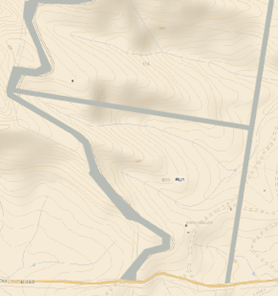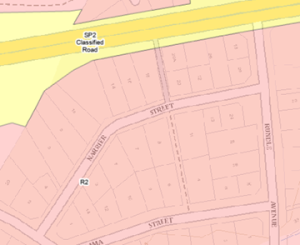Establishing the category of road
Private Road Disputes - October 2023
Private Road Disputes - October 2023
The first step in a potential private road matter is confirming that the category of road is a private road. By confirming that the category of road is a private road, you will also confirm and/or identify the relevant parties to the dispute. This page assists legal workers in determining whether the road in dispute is a private road.
If a road that is used to access property or is situated on private property is damaged following a disaster, you must first establish the category of road. This distinction is important as the responsibility for repairing the road is dependent on the classification and the owner. The ownership of the private road must also be determined.
This page details the steps involved in establishing the category of road, which are as follows:
Establish the road boundaries and ownership
Rule out public roads and Crown roads
Identifying the relevant parties to a potential private road dispute is crucial. You can find this information on the Certificate of Title and deposited plan relevant to the property over which the road passes.
The Certificate of Title and deposited plan will also help you determine whether the damage to the private road is within the applicable lot boundaries.
A title search is a current copy of the Certificate of Title which will show the current owner(s) of a property, the land description and any registered interests or dealings associated with the property that owners need to be aware of.
The title search will be useful to determine ownership of a road, if it is private, and whether any relevant easements are registered.
The deposited plan will define the legal boundaries of the relevant land and its legal identity. These plans often show road corridors within or adjacent to the property and may show if a road passing through the relevant land is not a private road.
Reviewing the deposited plan is important to confirm ownership and location of the private road.
Copies of the relevant Certificate of Title and deposited plan may be requested from the client (if acting for the landowner) or through an Information Broker.
For more information on Information Brokers in NSW see:
https://www.nswlrs.com.au/Titles-Dealings/Title-Information-(1)/Information-Brokers
As private roads are defined under the Roads Act as ‘any road that is not a public road’, the first step you should take is to confirm the road is not a public or Crown road.
An enquiry to the local council authority requesting confirmation of the classification of the road may be the simplest route to determining the road status as public, Crown or private. An enquiry may be sent to the contact email address for the relevant council, found on the council’s website.
If the council is unable to determine the category of road or does not respond promptly/within a reasonable time, you can complete a Transport for NSW – NSW Road Network Classification and Spatial Viewer online search. If these are indeterminate you can purchase a road status search from the relevant public authority. We explain how to do this below.
First, review the Transport for NSW online NSW Road Network Classification Map available at the following link: https://roads-waterways.transport.nsw.gov.au/classification/map/.
This tool assists in determining whether a Road is a:
The classification map can be used to demonstrate that the relevant road is not a public road. If the road is listed as either a State Road, Regional Road, or Local Road then it is a public road and it is not the landowner’s responsibility to repair or maintain damage incurred. The damage should instead be referred to the relevant council or road authority.
If the road is not listed as either a State Road, Regional Road, or Local Road, then you should confirm that the road is not a Crown road as outlined in the next section).
If it is unclear from the classification map whether the road is public or private, then enquiries regarding the classification of individual roads can be directed to the relevant Transport for NSW Regional Office.
Second, review the NSW Planning Portal Spatial Viewer available to access at the following link: https://www.planningportal.nsw.gov.au/spatialviewer/#/find-a-property/address.
This tool assists in determining whether a road is a:
Once you have entered the Planning Portal, enter/search for the address of the property. Then on the left a ‘Layers’ list should be on screen. Under subheading ‘Principal Planning Layers’ then subheading ‘Land Zoning Map’ turn the option ‘Land Zoning Map’ on. Under subheading ‘Crown Land’ turn option ‘Crown Land’ on. The diagram below shows where you can enter and select the relevant conditions:

Once these options are selected, the map should show if the road is a classified road or whether the road is on Crown land.
Sometimes, the spatial viewer does not distinguish Crown roads from Crown land; both are shown in grey. However, in this instance, Crown roads can often be distinguished due to their long thin shape and the grey colour of the road (this matches the colour shown in the Legend tab for Crown Land).
These images show examples of Crown roads as represented on the spatial viewer:


If you are unable to determine if the road is a Crown road using the spatial viewer, an application for a Crown land status search may be conducted to confirm whether the road is a Crown road, for a fee.
Before you apply for a search on the status of Crown Land, you should use the free ePlanning Spatial Viewer.
There are two types of searches available:
This search is limited to defining the authority responsible for the road.
Searches may be conducted online at: https://www.crownland.nsw.gov.au/resources/order-search-status-crown-land/order-search-status-crown-land-online
Private road disputes are complex.
Once you have established the category and ownership of the road, determine whether you are acting for the landowner or the private road user.
The required steps to manage a private road dispute for landowners and private road users are set out respectively at:
Flowcharts are included in both sections to assist in providing advice for private road disputes regarding damage sustained following a disaster and are relevant only to the party that you are acting for.
This resource provides legal information for private road disputes only.
If you have determined that the road is a public or Crown road, then this resource will no longer be able to assist.
Your client may be eligible for pro bono legal support from Justice Connect. To refer your client, visit our website:
I need to refer someone – Refer to Justice Connect.
We have also developed a self-help resource for help-seekers impacted by a damaged public or Crown road, here: The Crown or public road I use to access my property was damaged following a disaster. Can I make the council repair it? (NSW) – Justice Connect
This resource was last updated on 31 October 2023. This is legal information only and does not constitute legal advice. You should always contact a lawyer for advice specific to your situation. You can read our full disclaimer here: Disclaimer and copyright for our Disaster Legal Support Resource Hub – Justice Connect.